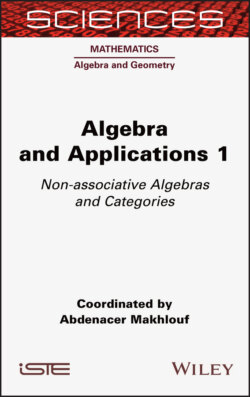Читать книгу Algebra and Applications 1 - Abdenacer Makhlouf - Страница 11
1.1. Introduction
ОглавлениеSuperalgebras appeared in a physical context in order to study, in a unified way, supersymmetry of elementary particles. Jordan algebras grew out of quantum mechanics and gained prominence due to their connections to Lie theory. In this chapter, we survey Jordan superalgebras focusing on their connections to other subjects. In this section we introduce some basic definitions and in section 1.2 we give the Tits–Kantor–Koecher construction that shows the way in which Lie and Jordan structures are connected. In section 1.3, we show examples of some basic superalgebras (the so-called classical superalgebras). Section 1.4 is about the notion of brackets and explains how to construct superalgebras using different types of brackets. Section 1.5 explains Cheng–Kac superalgebras, an important class of superalgebras that appeared for the first time in the context of superconformal algebras. The classification of Jordan superalgebras is explained in section 1.6, and it includes the cases of an algebraically closed field of zero characteristics, the case of prime characteristic, both for Jordan superalgebras with semisimple even part and with non-semisimple even part, and the case of non-unital Jordan superalgebras. Finally, in section 1.7, we give some general ideas about Jordan superconformal algebras. Throughout the chapter, all algebras are considered over a field F, charF ≠ 2.
DEFINITION 1.1.– A (linear) Jordan algebra is a vector space J with a linear binary operation (x, y) ↦ xy satisfying the following identities:
(J1) xy = yx (commutativity);
(J2) (x2y)x = x2(yx) ∀x, y ∈ J (Jordan identity).
Instead of (J2) we can consider the corresponding linearized identity:
(J’2) (xy)(zu) + (xz)(yu) + (xu)(yz) = ((xy)z)u + ((xu)z)y + ((yu)z)x ∀x, y, z, u ∈ J.
REMARK 1.1.– A Lie algebra L is a vector space with a linear binary operation (x, y) ↦ [x, y] satisfying the following identities:
(L1) [x, y] = –[y, x] (anticommutativity);
(L2) [[x, y], z] + [[y, z], x] + [[z, x], y] = 0 for arbitrary elements x, y, z ∈ J (Jacobi identity).
EXAMPLE 1.1.– If A is an associative algebra, then (A(+), ∙), where a ∙ b = ab + ba is a Jordan algebra, and (A(–), [, ]), where [a, b] = ab – ba is a Lie algebra. Both A(+) and A(–) have the same underlying vector space as A.
DEFINITION 1.2.– A superalgebra A is an algebra with a ℤ/2ℤ-grading. So is a direct sum of two vector spaces and
Elements of are called homogeneous elements. The parity of a homogeneous element a, denoted |a|, is defined by |a| = 0 if and |a| = 1 if .
Elements in are called even and elements in are called odd.
Note that is a subalgebra of A, but is not, instead it can be seen as a bimodule over .
EXAMPLE 1.2.– If V is a vector space of countable dimension, then G = G(V) denotes the Grassmann (or exterior) algebra over V, that is, the quotient of the tensor algebra over the ideal generated by the symmetric tensors v ⊗ w + w ⊗ v, v, w ∈ V. This algebra G(V) is ℤ/2ℤ-graded. Indeed, , where the “even part” is the linear span of all tensors of even length and the “odd part” is the linear span of all tensors of odd length.
G(V) is an example of a superalgebra.
DEFINITION 1.3.– Consider a variety of algebras V defined by homogeneous identities (see Jacobson (1968) or Zhevlakov et al. (1982)). We say that a superalgebra is a V-superalgebra if the even part of A ⊗F G(V) lies in the variety, that is
DEFINITION 1.4.– The algebra is called the Grassmann envelope of the superalgebra A and will be denoted as G(A).
Let us consider V the variety of associative, commutative, anticommutative, Jordan or Lie algebras, respectively. Then we get:
EXAMPLE 1.3.– A superalgebra is an associative superalgebra if and only if it is a ℤ/2ℤ-graded associative algebra.
EXAMPLE 1.4.– A superalgebra is a commutative superalgebra if it satisfies:
for any x, y homogeneous elements of A.
EXAMPLE 1.5.– A superalgebra A is an anticommutative superalgebra if
for every x, y homogeneous elements of A.
EXAMPLE 1.6.– A Jordan superalgebra is a superalgebra that is commutative and satisfies the graded identity:
for every homogeneous elements .
EXAMPLE 1.7.– An anticommutative superalgebra A is a Lie superalgebra if it satisfies:
for every .
DEFINITION 1.5.– If is a Jordan superalgebra and , then their triple product is defined by:
Note that every algebra is a superalgebra with the trivial grading, that is, .
